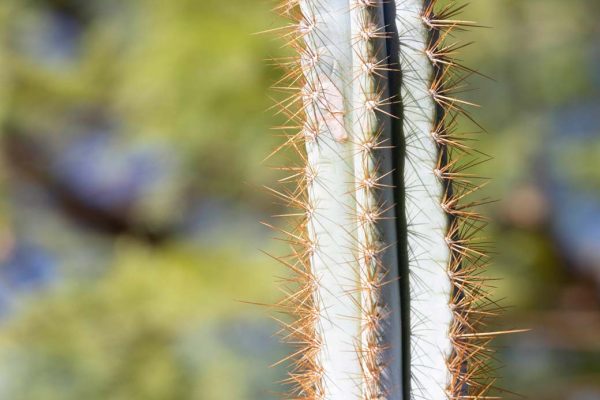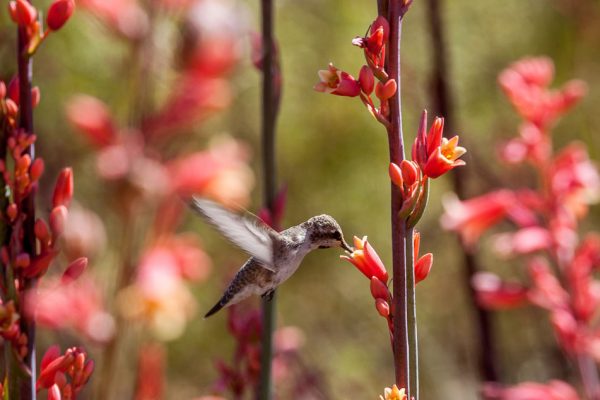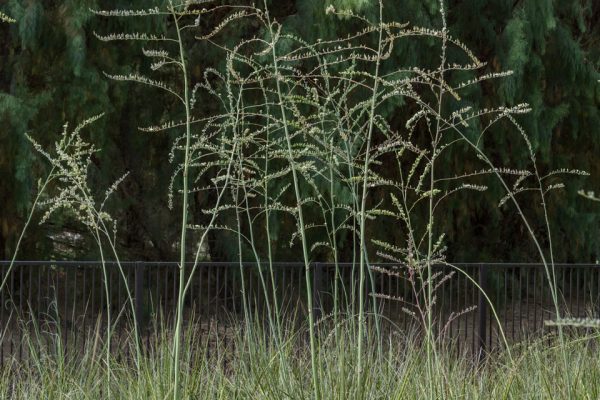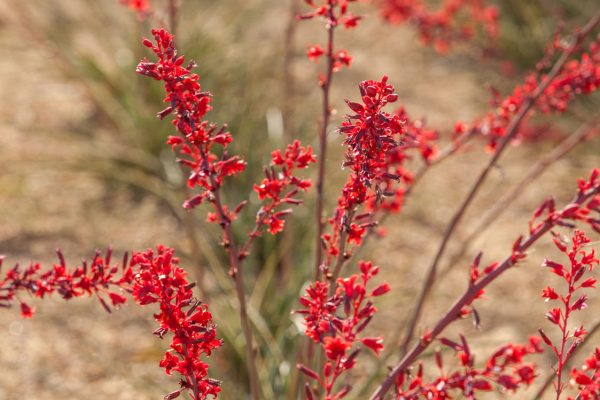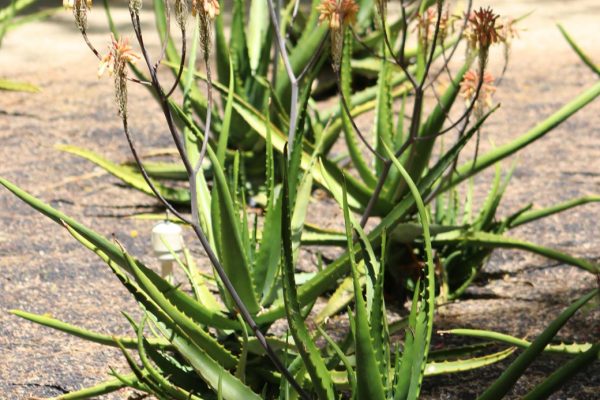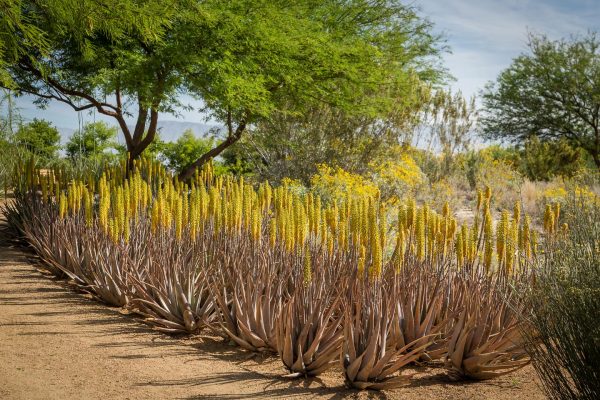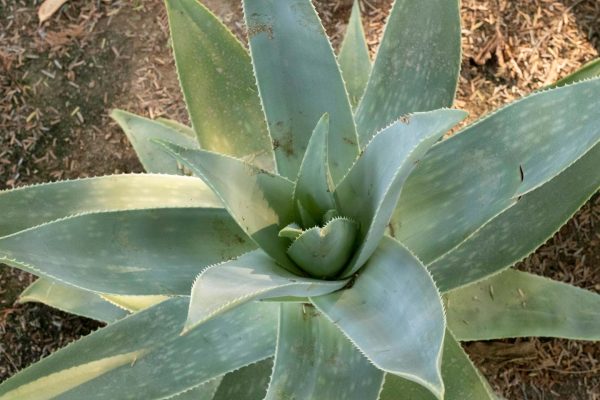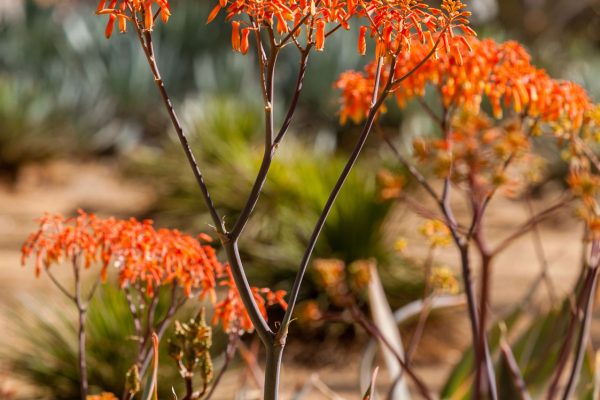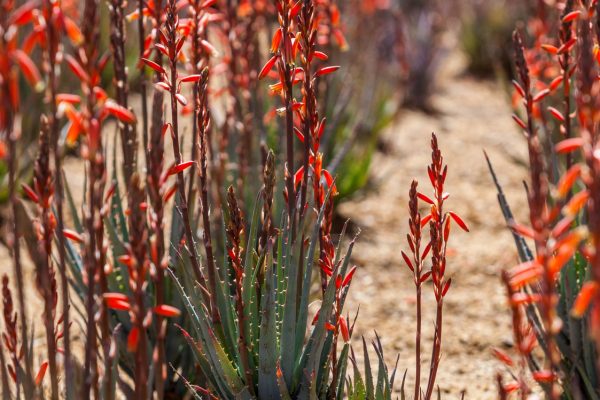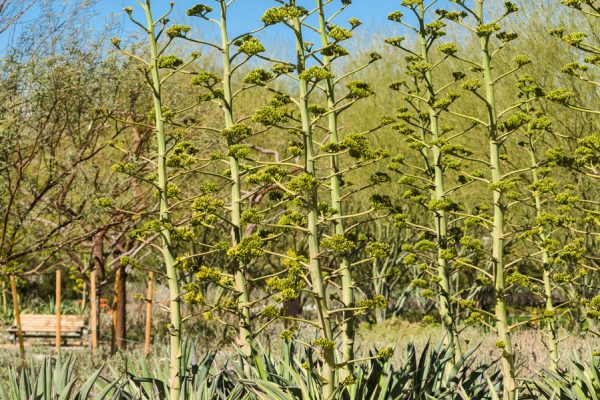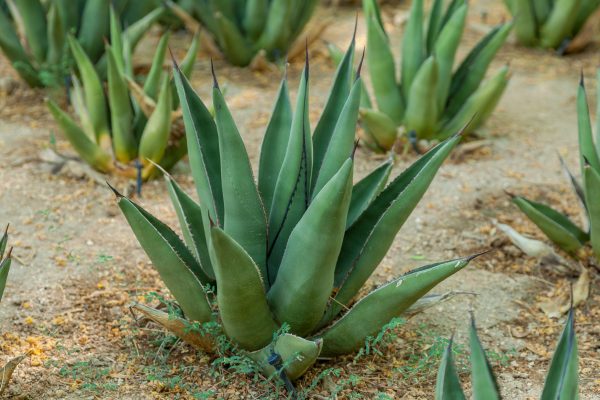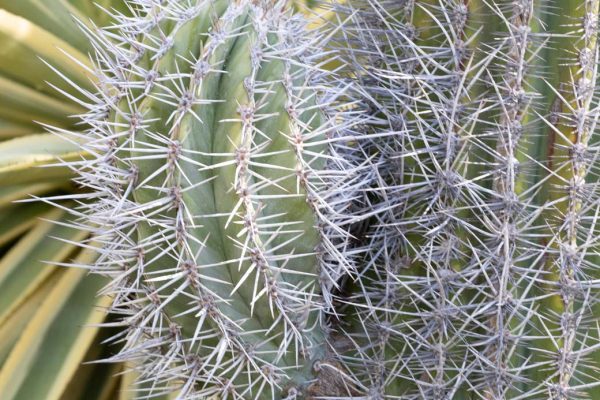
Cardon can grow to 36 feet, and its spines are gray to white. There are three Cardon in the specimen beds nearest the solar field. They are still quite young and were less than 5 feet tall when planted during the original installation.
The Cardon is part of a family that consists of over 12 other large columnar cactus species under the genus Pachycereus (Greek for “thick” and “torch”). These botanical groupings for cactus are a bit fragile, and more phylogenic (genetic tracing) work needs to be completed. Not all cactus have had their genetic connections confirmed. In some groupings, they do not share the same taxonomic features and may later be determined to be unrelated. For now, they are grouped based on similar size and their candelabra structure. There are three species in the gardens that fall into this genus: Cardon, Fencepost, and Totem Pole.
When mature, they will display funnel-shaped, white flowers that will bloom both day and night, attracting multiple pollinators. This genus Pachycereus also has significant ethnobotanical uses by desert native cultures.
Distribution of Cardon includes the Sonoran Desert states of Sonora, Baja California, and Baja California Sur in Mexico. The Baja location is why it can be referred to as Baja Saguaro.
Blue Torch is in the specimen beds between the café and the solar field. A stunning columnar cactus, Blue Torch can range from a gray-blue to almost sea-foam blue in color. This species can grow to 20 feet, becoming tree-like with a center stalk and erect branches. Its golden spines will become gray with age.
The species azureus is synonymous with pachycladus, which is the name used in Edward F. Anderson’s 2004 edition of The Cactus Family.
The blooms of this genus are highly variable with some displayed as short and cup-shaped, and others reaching farther out to elongated bell-shapes. The bloom color is consistently creamy white.
The pachycladus is one of two distinct subspecies in Brazil, occurring in Bahia and Minas Gerais, south of the 10° south latitude. A similar cactus from the species pernambucoensis is found naturally in the northeast, north of the 10° south latitude.

Our medium-sized Hesperaloe is the extremely popular parviflora species, called Red Yucca or Hesperaloe. Due to its easily managed size and beautiful flowers, it is one of the most common Hesperaloes you will see in public garden spaces. Growing up to 4 feet, it develops curving marginal filaments that pull away from the leaf edge, giving the appearance of coarse hair growing off the edges. This makes it easy to distinguish from other rosette-forming succulents.
Red Hesperaloe grows a flowering stalk called a raceme. It can grow to a height of 9 feet, though at Sunnylands it grows normally between 6 and 7 feet, much lower than the 16 foot raceme of its cousin Giant Hesperaloe. Its blooms vary in color through natural garden cross-pollination and human cultivation, but they tend to stay in the dark red to coral pink ranges. This species is a parent of the smaller Hesperaloe called Brakelights, also planted at Sunnylands.
Hesperaloe in general appears to be popular with not only nectaring hummingbirds but also with opportunistic Monarch and Queen Butterfly caterpillars. When Hesperaloe is placed near milkweed beds, chrysalis of both butterflies have been found attached to its leaves. But chrysalis also has been found on agaves, so this is not an identifying feature.

The Giant Hesperaloe is the largest species of the genus Hesperaloe. This giant grows a rosette of crescent-like leaves that reach 6-feet high. For those not familiar with the differing desert genera that grow in a similar style, it can be difficult to distinguish them when not in bloom. Hesperaloe has one helpful indicator for identification, no this pattern is not exclusive to this genus, it helps identify it in these gardens. It is curving marginal filaments that pull away from the leaf edge, giving the appearance of coarse, white hair growing off the edges. If you see those, you then need to determine which species of Hesperaloe you are seeing in the gardens, which is easy. You simply determine, if it is in the 6 foot leaf range and if it is, you are probably looking at the Giant as there are only three species in the gardens, and they fall into the large, medium, and small categories.
Hesperaloe can expand by clumping additional tiny rosettes around the parent plant, as well as setting seed through flowering. They also readily cross-pollinate and hybridize. Giant Hesperaloe displays both pink and white blooming varieties, which grow on a flowering stalk called a raceme. The raceme can reach up to 16 feet. The creamy-white flower is associated with the original funifera species, but the other is a pinkish-toned hybrid. These are both pollinator favorites.
Hesperaloe in general appears to be popular with not only nectaring hummingbirds but also with opportunistic Monarch and Queen Butterfly caterpillars. When Hesperaloe is placed near milkweed beds, chrysalis of both butterflies have been found attached to its leaves. But chrysalis also has been found on agaves, so this is not an identifying feature.

Brakelights is the smallest of the Hesperaloe species at Sunnylands. The term [perpa] in its name means it is a copyrighted variety created through intentional cultivation. From this name, you can probably guess that it was cultivated to accentuate the deepest red variations that have occurred in the parviflora species.
Brakelights has a longer bloom period than its parviflora parent, which is possible because it does not set seed. The additional energy not used in the seed-setting processes allows it to extend its season. It blooms a deep red, but can be tinged with dark purple, making it incredibly striking to see in contrast to the lighter coral and cream blooms of its parent.
Hesperaloe in general appears to be popular with not only nectaring hummingbirds but also with opportunistic Monarch and Queen Butterfly caterpillars. When Hesperaloe is placed near milkweed beds, chrysalis of both butterflies have been found attached to its leaves. But chrysalis also has been found on agaves, so this is not an identifying feature.
The Nubian Aloe is another new addition to the gardens. It was added in 2016 to the northwest corner (the corner behind the Great Lawn closest to the solar field). Its leaves display a brighter green than other aloes in the garden.
Starting in January and continuing through the spring, blooms appear on a multi-branching stalk in colors closer to peach and apricot, not the reds and yellows of other aloes at Sunnylands. Like the Ghost Aloe, Nubian’s blooms appear bundled in clusters at the end of each branch. The blooms are a combination of yellow and peach tones, providing a softer appearance than other, more vibrant aloe cousins.
Nubian Aloe is indigenous to Ethiopia and Eritrea in Africa.
Groupings of Medicinal Aloes completely fill their planting beds throughout the gardens as they rapidly produce pups at their base. Growing to heights of 3 feet, their formal structure is effective as both an eye-catching backdrop for some smaller specimens and a front-and-center showstopper along other garden paths.
Medicinal Aloe is particularly striking from January through spring when it blooms in mass. Tall bayonets of yellow flowers create a frenzy of pollinator competition as bees and hummingbirds dodge each other to visit each bloom. The bloom stalks remain in place until all have completed their full cycle through seed setting—communicating that while the Sunnylands garden is an aesthetic garden, laid out with an artistic intent, it also embraces the natural process that allows each plant to complete its cycle.
The origin of Medicinal Aloe is the Arabian Peninsula, but today it is widely propagated around the world for both its aesthetic and medical qualities.
The Ghost Aloe is not a plant from the original landscape plan completed when Sunnylands opened in 2012, but its parent, the Coral Aloe is. Ghost Aloe is a smaller version of Coral Aloe with a tighter rosette. It’s less casual in its structure and has a frosty coloration that gives it the ethereal common name of Ghost.
The blooming structure of this Aloe is not a bayonet appearance like the Medicinal Aloe. It, like Coral Aloe, has a multi-branching stalk topped with a candelabra-type gathering of orange-red flower blooms.

Coral Aloe is in the shaded garden beds outside of the path that surrounds the Great Lawn. Its appearance is an interesting contrast to the more formal structure of the Medicinal Aloe. Its wide and flat leaves are greenish-blue with a light pink margin (edge), but unlike the upward reaching leaves of the Medicinal Aloe, its relaxed leaves appear to flop open as it bathes in the dappled light under the Palo Verde trees.
Like other aloes, it blooms annually starting in January and continues through spring. The flower stalk differs from Medicinal Aloe and Blue Elf. Where they grow a single stalk in the shape of a bayonet, this multi-branching species has blooms that spread wide, like a tree canopy. The flowers are bright red-orange with a creamy-white tip. After the bloom, it sets seedpods that resemble green grapes. Like some other succulents, Coral Aloe will form clones or pups around the base, which can be collected and replanted.
The origin of Coral Aloe is the Cape Provinces of Africa, where it prefers the driest areas and elevations ranges of 800 to 7,300 feet.

Blue Elf is a small but mighty succulent that can withstand the sun’s full attention on the hot desert floor. The smallest of the aloes at Sunnylands, its clumping nature allows it to spread readily to 2 feet. Visitors will first experience Blue Elf when walking to the front of the Center. It’s found growing in four beds below the Sweet Acacia trees that frame the entrance and anchor the entry circle. It is also on the west side of the gardens where it replaced the less successful Angelita Daisy (Tetraneuris acaulis) from the original 2012 landscape plan. It has proven to be a true powerhouse in the gardens.
The leaves of the aloe sometimes display a pink blush. This is the result of a protection mechanism that helps prevent plant cell sun damage. This response is linked to the storage of the pigment rhodoxanthin in the cells of aloes and can be triggered by environmental stressors, such as low water, but it’s usually seen on plants in full sunlight, which is the other environmental trigger. Planting in shade can reduce the blush, but too much shade may also inhibit its blooms.
Blooming begins annually in January and continues in mass through spring, but other times of the year a single aloe may send up a rogue flower stalk catching visitors’ full attention. Its flower stalk will top out at only 18 inches, displaying red-orange tubular flowers that are the delight of hummingbirds. This easy to grow plant has proven to be most popular with the dozens of Costa’s and Anna’s Hummingbirds that inhabit the gardens.
Reported in North Africa in the Canary and Cape Verde Islands.
Some Smooth Agave began blooming within a season of their planting. In order to ensure that the Center & Gardens would look established on opening day in 2012, some more mature specimens were used. For the agaves, this meant they would be closer to blooming. The first specimen began to bloom in 2013 and additional ones have continued blooming each year since. This has offered visitors the opportunity to see blooms each season, which is great for the experience but results in the necessity of replacement of individual plants.
The Smooth Agave sends up a thick, branching stalk that blooms bright yellow and then forms bulbils (small, fully formed plants), which can be replanted. Smooth Agave does not exist in the wild but is common in cultivation and its offsets form early, so replanting is not difficult.
It has been found to be cold sensitive and die off of lower leaves immediately after a frost is possible.
Not just a fun name, Sharkskin, with its thick, triangular leaves, is a visually appealing, and sturdy agave. Its name comes from the textural feel of its skin that resembles the feel of shark skin. Described as “stout” or “muscular” due the thickness of its leaf base, it maxes out at 3 feet in height. To some it may look like just another agave, but to those who look for slight variations among varieties, it is distinctive.
Sharkskin is pest resistant. It has proven to be a low maintenance selection at Sunnylands, and due to its lack of a finicky nature, so it does well throughout the gardens.
Its origin is Mexico as a hybrid of A. ferdinandi-regis form of A. victoriae-reginae.

